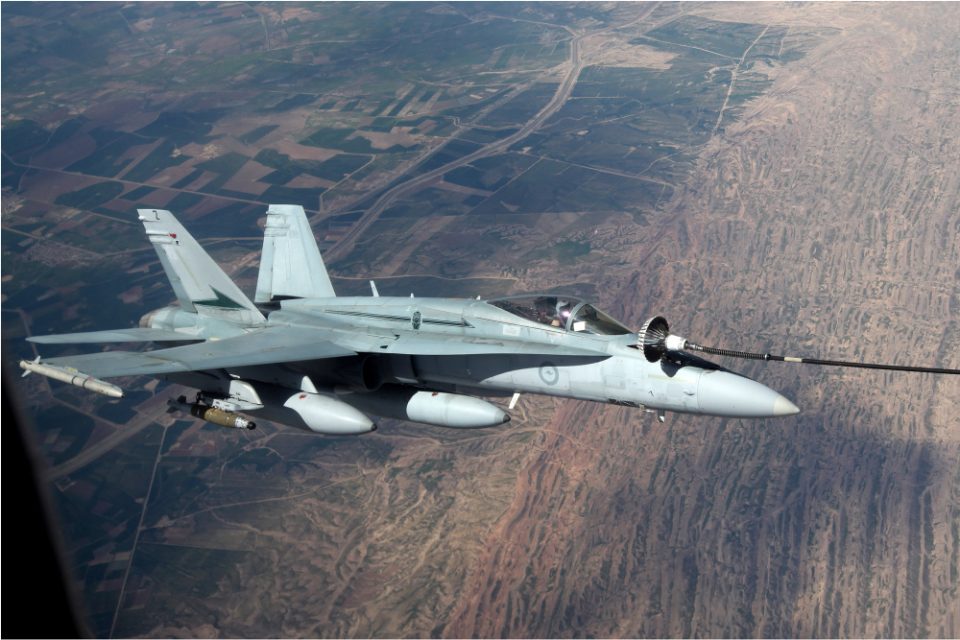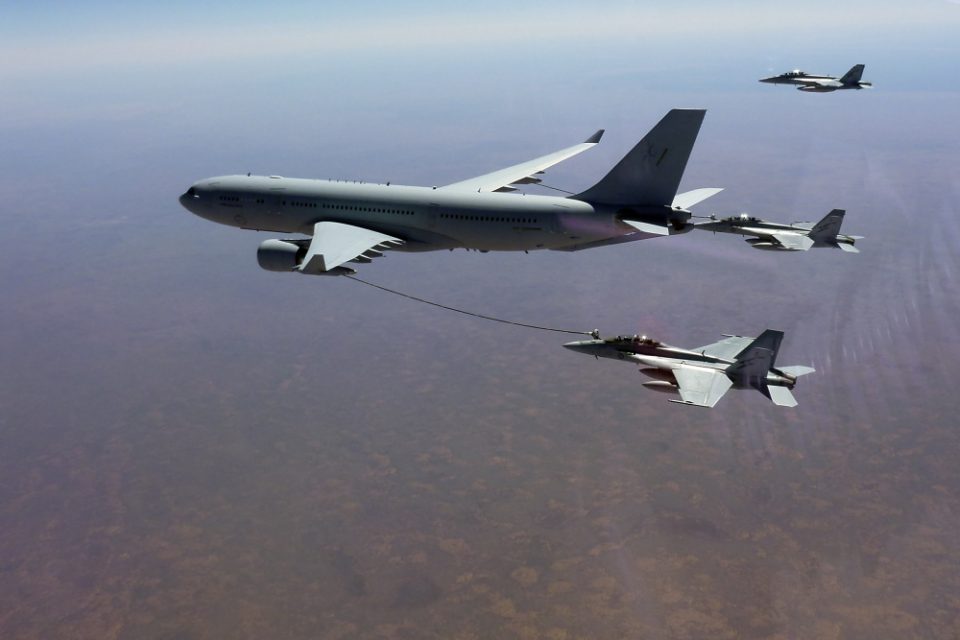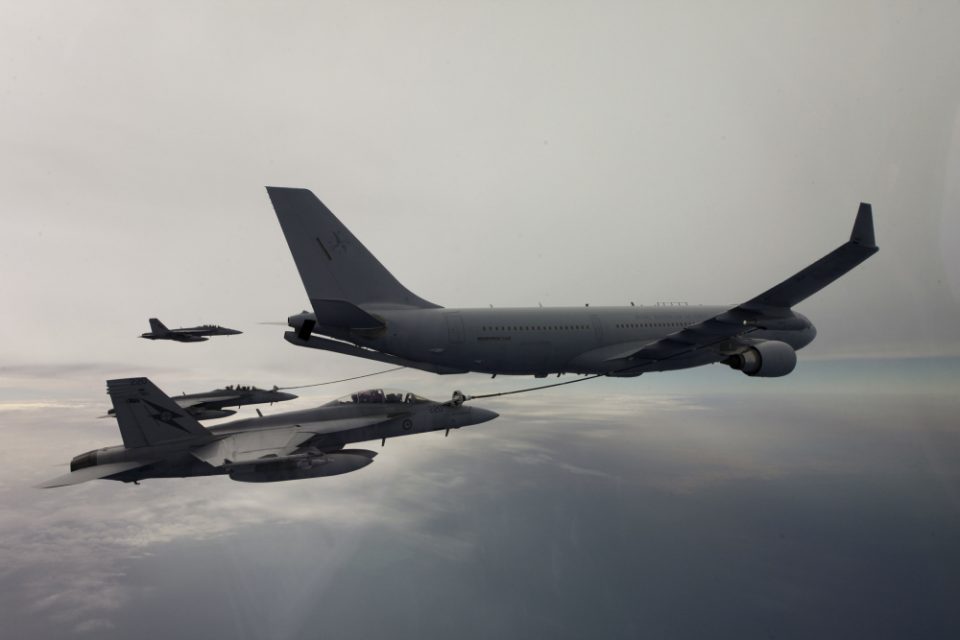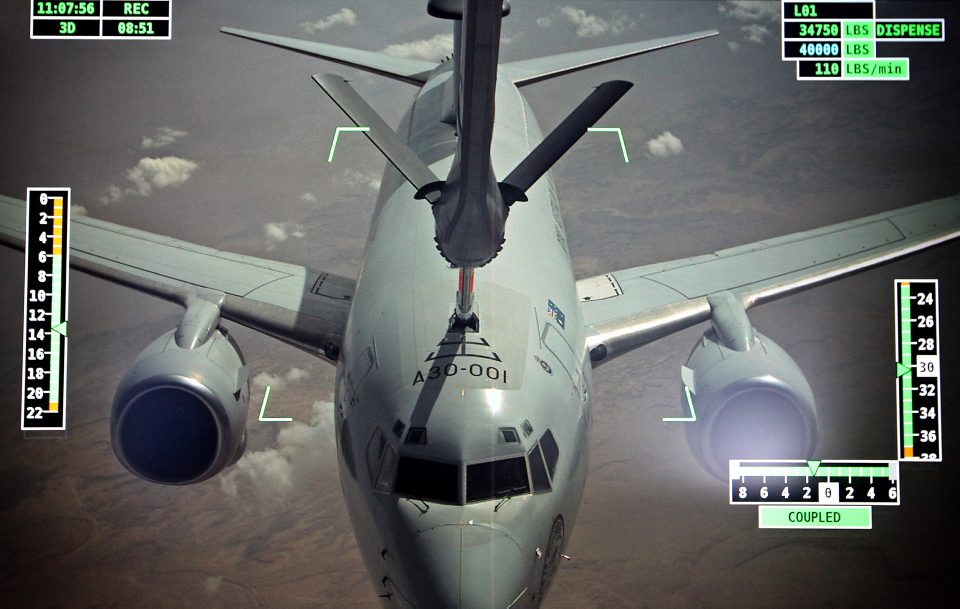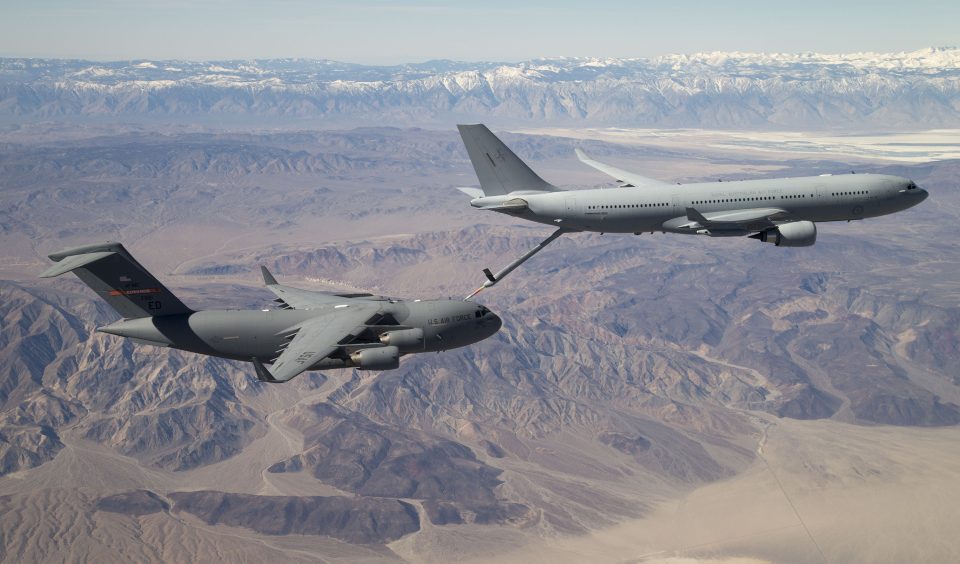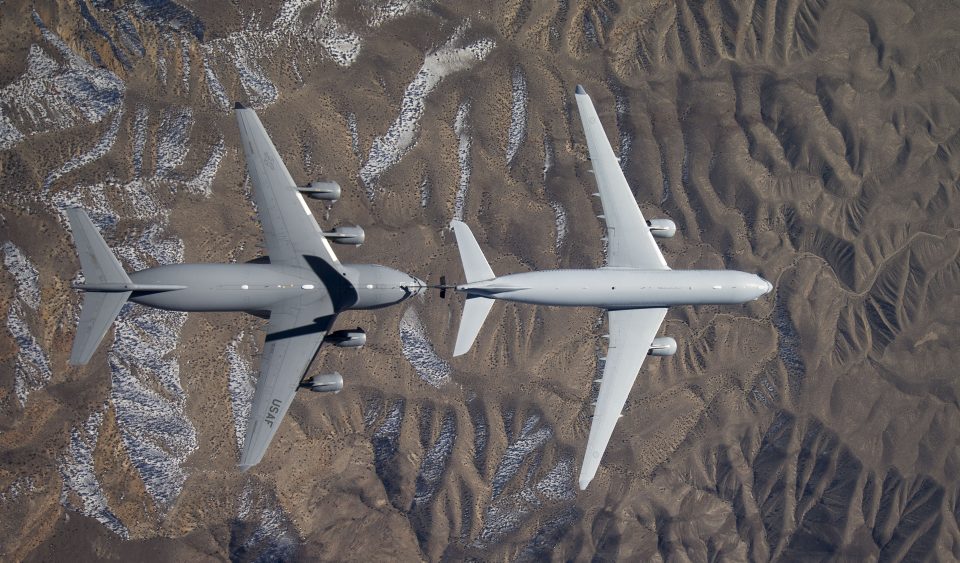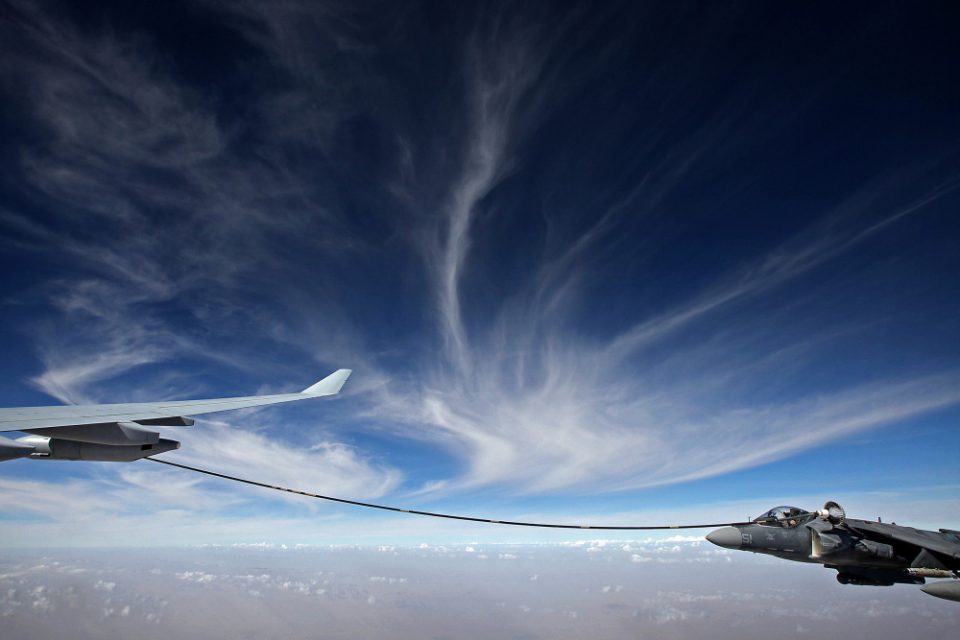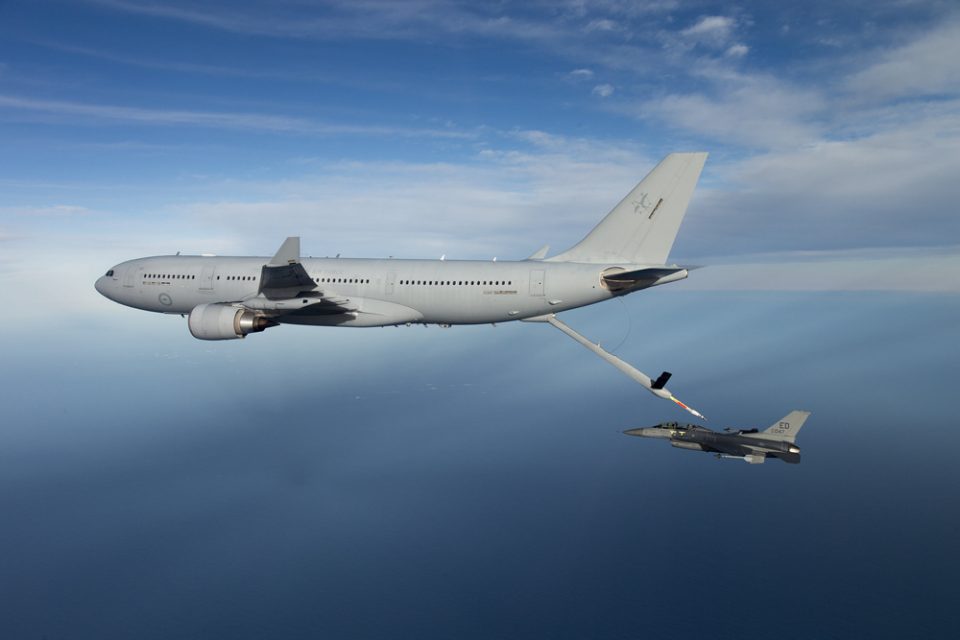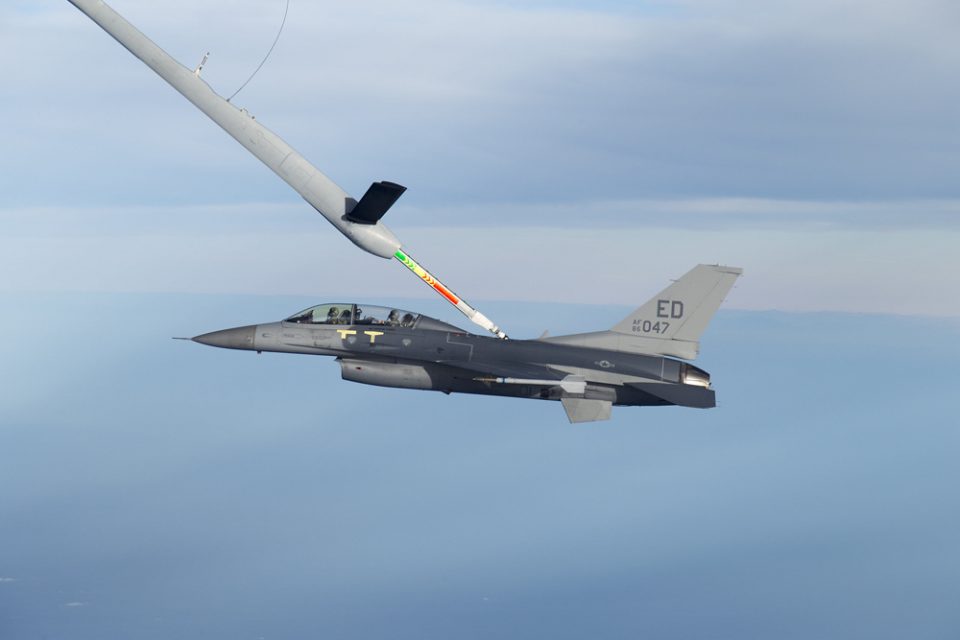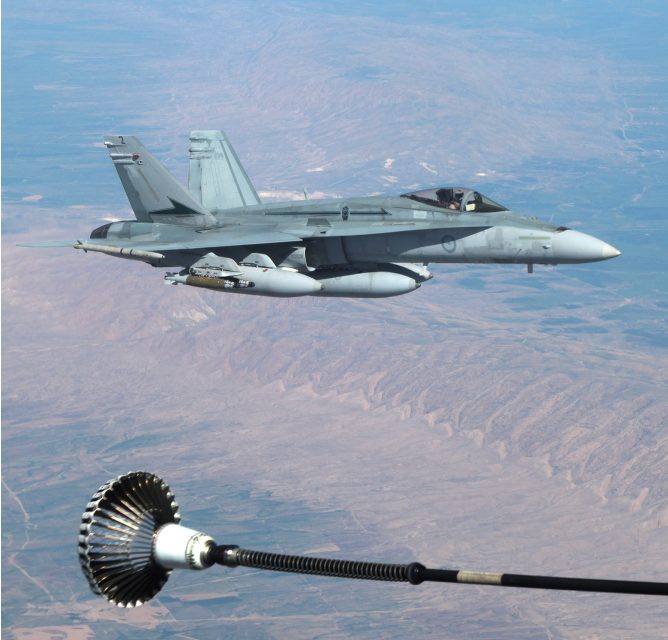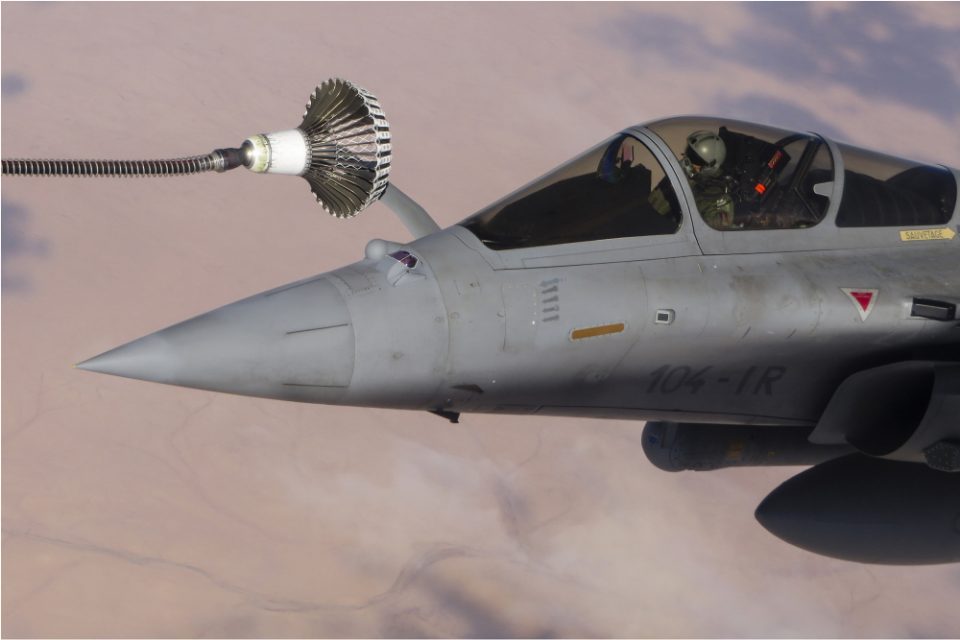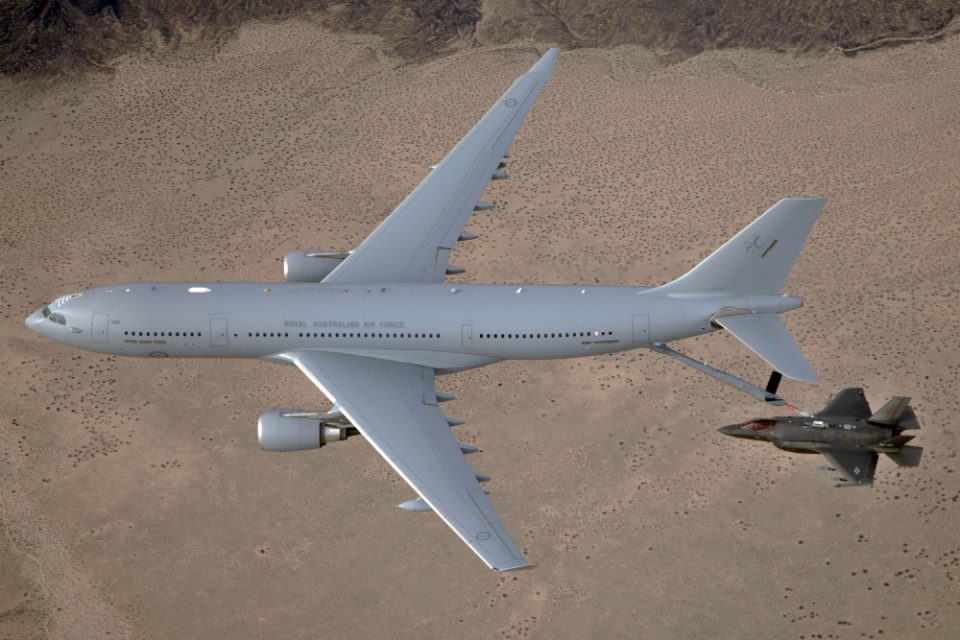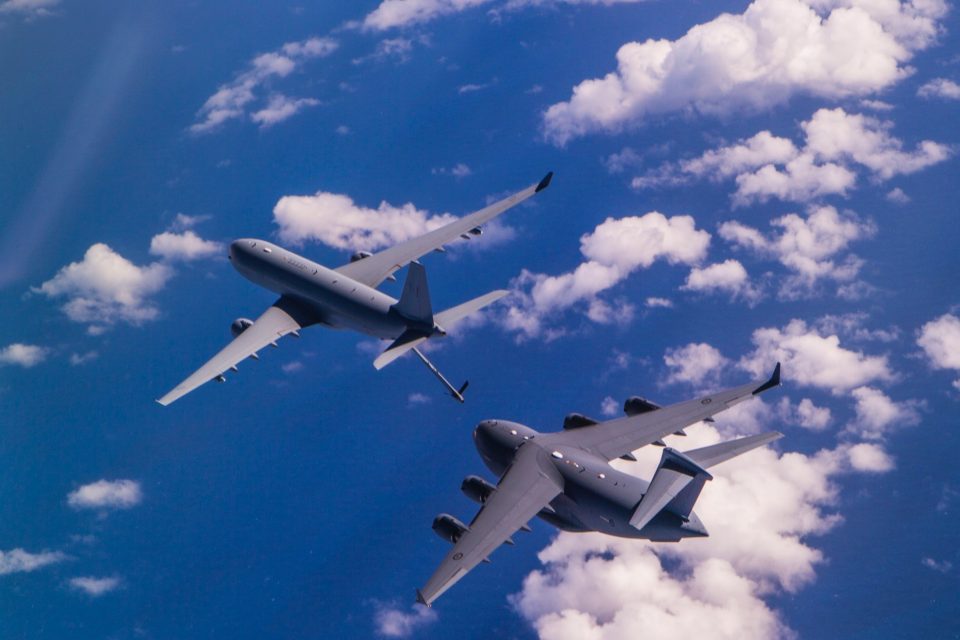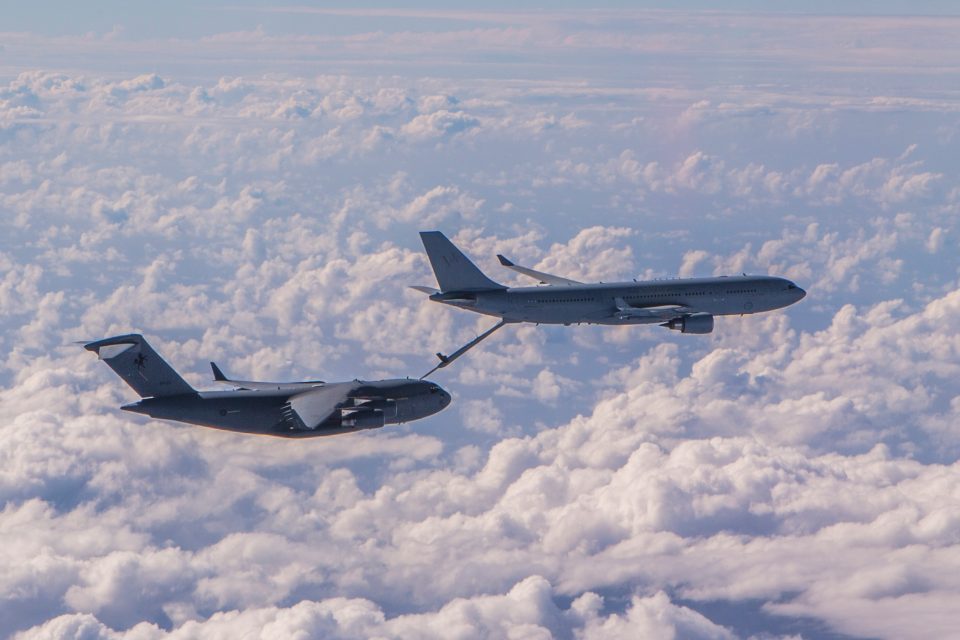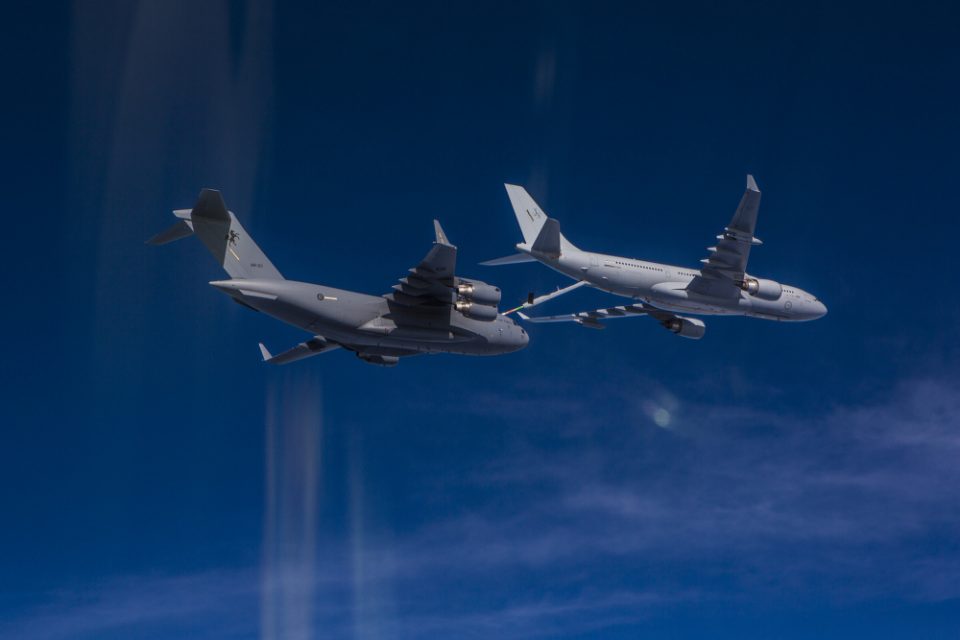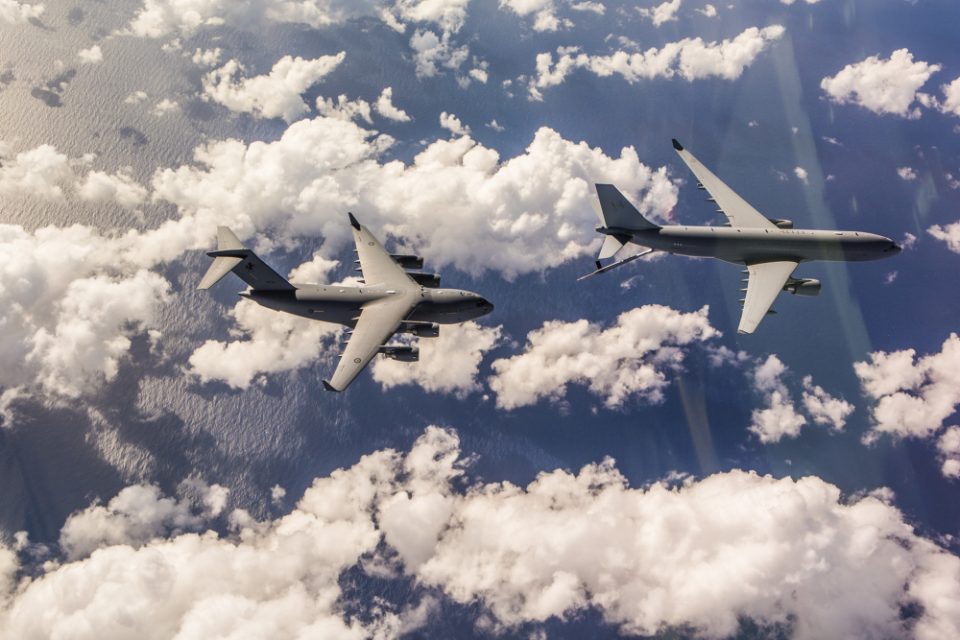2016-04-30 By Robbin Laird and Ed Timperlake
After our day with the F-35 Developmental Test Team at Edwards AFB, we met with the KC-30A team at Edwards. The team was continuing the effort to clear the tanker boom with an ever-growing number of receiver aircraft.
The team we met with had experience with the aircraft during its current operations and the Middle East and provided a good overview to the aircraft, its evolution, and its role in shaping what has been the first engagement of the RAAF with its new combined air capabilities of Wedgetail, KC-30A, fighters and support and C2 elements to a long-distance operation.
This new capability of the RAAF to deploy a sovereign force package provides the Australian Defence Force and the Australian political leaders with new options and possibilities for national or coalition engagements worldwide.
The members of the team who participated in the interview are as follows:
- SQNLDR Jamie Minor, 33SQN KC-30A Captain
- SQNLDR Lee McDowall, Aircraft Research and Development Unit (ARDU) Senior Flight Test Engineer (FTE)
- FLTLT Tom Hawes, 33SQN KC-30A Co-pilot
- FLTLT Jacques Le Roux, ARDU FTE and KC-30A/C-17 Clearance Flight Test Lead
- FLTLT Ben Liersch, ARDU FTE and KC-30A/F-16 Clearance Flight Test Lead.
The main purpose of the team at Edwards was to work on C-17 and F-16 certification for the KC-30A boom.
The tanker has operated the hose and drogue system for some time, but the boom is just now becoming IOC’d.
The number of aircraft certified has been growing and includes, RAAF Hornets and Super Hornets, USN Hornets and Super Hornets, the French Rafale, the Eurofighter and Tornado (via Voyager certifications), the Harrier and Prowler, the F-35, the Wedgetail, and upon leaving Edwards will have finished C-17 and F-16 clearances as well.
Question: When visiting the tanker squadron a couple of years ago and prior to your deployment to the Middle East, you were working on getting the boom operational.
How did that process happen?
Answer: Air Vice-Marshal Chris Deeble was given the task of shaping a way ahead.
And he did this by reworking the relationship with Airbus so that there could be a complete sharing of data and information to get the boom operational as effectively and quickly as possible.
We formed a joint committee or an integrated team where we shared all knowledge and work towards finding a common solution for the way ahead.
We removed the barriers that were artificially in place between Airbus and ourselves.
We pared down our requirements to those, which were both needed and realistic, and got rid of the ones which were generated more by our bureaucratic process than by what was needed for operational realities.
We wanted to get a capable and effective system more rapidly through this process and that is what has happened.
Question: Those who do not know about your tanker will not know that you tank from the front, rather than the rear of the aircraft.
What advantages has this given you in operations?
Answer: A major advantage when combined with the IR cameras and illuminations is that we can operate at night as effectively as in the day.
The view is so crisp that we can see the receiver pilot’s teeth when he comes in for fuel.
It is absolutely amazing.
And teamwork is much better.
We can have a very integrated team of the pilot, co-pilot and ARO (Air Refueling Officer) working together on the flight deck to work the mission with the aircraft coming in for fuel.
Question: Could you talk about your operational experiences?
Answer: With a new program, generally, you crawl, walk and then run.
With this program, we needed the capability relatively quickly so we sort of crawled and then ran.
The deployment to the Middle East has rapidly accelerated our maturing of the aircraft.
We went to the Middle East in the Fall of 2014.
We operate one tanker at a time in Operation Okra and a deployment is four months.
Some airmen have already completed three or four rotations in the mission.
Even though we have only one tanker there, we are delivering more than 10% of all the fuel in the operation.
We have offloaded around 40-45 million pounds of fuel in the Middle East during the operation to coalition forces.
We are operating at 96-98 percent mission success rate, and the maintenance has been outstanding.
It is a commercial plane with military systems onboard and is built for rapid fuel intake, for commercial airlines expect to turn around planes rapidly.
They don’t make money with the plane on the ground.
We can do this as well, but are limited only by the austere conditions at military bases which slows the refueling process.
And the efficiency of the engines is outstanding which means that we burn less fuel than a KC-10 or KC-135 when flying and doing the tanking operations.
Question: With the situational awareness which you have on the plane, you operate the plane often to the fighter rather than forging a track to which the fighter goes.
Could you describe that capability?
Answer: We have a very good communications suite, including SATCOM, on the aircraft, as well as Link 16.
So we can see the fighters in the battlespace and we can see their fuel loads and anticipate where the need for refueling might lie.
It is about positioning yourself efficiently to refuel fighters to get them back in the fight as rapidly as possible; it is not just about being a tracked gas station in the sky.
And with our communications capabilities we can act as a relay between the fighters and other assets in the battlespace and link back to the home base as needed as well.
We can function as a communications relay for the fighter fleet as well.
Question: You are reshaping the tanker culture?
Where do your crews come from and how are they preparing for the boom part of your tanker’s future?
Answer: We have a mixture of people with fighter, tanker and airlift experience.
It is a mixed crew in terms of background.
And we have an exchange with the USAF with the KC-10 are building up our boom training and experience with them as well.
Question: How are the coalition partners responding to your tanker and your efforts?
Answer: We are the tanker of choice.
The amount of respect we are getting from being in the Middle East, I’ve never seen anywhere else. Especially from Marines and the U.S. Navy, we constantly hear: “We want you guys every time we’re going to do a strike package.”
So whenever there’s a strike package happening, they request us when possible: “We want the Aussie KC-30 tanker on board.“
Question: The KC-30A is being used by a number of other Air Forces, although you are the lead country is using the aircraft. What have been your interactions with them?
Answer: We have growing interaction with non-USAF’s which is also broadening our mutual experience.
For example, we have an exchange with the French, whereby the French are leveraging our work to shape their transition strategy with their own tanker.
All of the clearances we are doing for ourselves benefit all the other KC-30A air forces.
And we think we are driving the entire KC-30A enterprise forward as well evolve our experience and our capabilities.
During the tests here, we have an Airbus person with us as we certify the boom.
We have embedded him in our team and put an Australian flag on his back and made him feel like one of us.
And that breaks down the barriers necessary to have the kind of innovation, which we want to see.
Editor’s Note: Not only are the Aussies evolving the qualitative elements of their tanking operations and culture, but they are increasing the numbers as well.
Because the MRTT is a derivative of a commercial aircraft, it is possible to leverage a used commercial aircraft as the baseline aircraft which can be modified.
This is what the Aussies are doing.
According to a story published on July 1, 2015 by Australian Aviation:
Australia is to acquire two further Airbus KC-30A tanker-transports, taking the RAAF’s fleet to seven, Defence Minister Kevin Andrews has announced.
“The two additional KC-30A aircraft will be delivered in 2018 and provide a substantial increase to the air-to-air refuelling capacity of the RAAF,” Andrews said in a statement on Wednesday.
“Defence has signed an update to the existing acquisition contract with Airbus Defence and Space for the two aircraft and associated conversion at a cost of approximately $408 million.”
The KC-30 (Airbus calls it the A330 MRTT – Multi Role Tanker Transport) is a development of the A330-200 airliner, featuring an ARBS (Advanced Refuelling Boom System) boom mounted beneath the rear fuselage and underwing mounted ‘probe and drogue’ pods. It also has a significant ‘air logistics support’ capability able to carry cargo in its underfloor freight compartments and, in RAAF service, 270 passengers in airliner-style seating.
Although four of the original five aircraft were converted from ‘green’ A330 airframes to their KC-30 configuration by Qantas Defence Services (now Northrop Grumman Australia Integrated Defence Services) at Brisbane Airport, the two new aircraft – secondhand ex Qantas A330-200 airliners – will be converted to tanker configuration by Airbus Defence and Space at Getafe, Spain.
Indeed, if one visits Getafe, Spain, it is possible to see the first Qantas modified jet.
It is to be found as of the end of April 2016, in the first of the three hangars through which over an 8-month period, the commercial jet becomes a tanker.
The second is standing outside of three hangars ready to enter the process of conversion.
By the way, in the other two hangars are the first and second Singaporean tankers being built from “green” commercial jets.
With regard to the qualitative evolution of the tanker and its culture, the Air Commander Australia, Vice Air-Marshal Gavin Turnbull had this to say:
What we have given the tanker crew is what the fighter pilot experienced in the first decade of the 21st century.
We added Link 16 into the cockpit and suddenly they had situational awareness of the battlespace around them and could now work within the battlespace, rather than simply going to a tanker track and acting as a gas station in the sky waiting for the planes to come in to get gassed up.
This has meant changing the skill set for the tanker crew as well.
We need to have smart people with smart situational awareness combat skills rather than truck drivers. They now position themselves where they’re next needed.
They’re maintaining their awareness and they’re moving into the battle space, and the jets are coming off their targets and are surprised about how close the tanker is.
In fact, we’re starting to get the reverse complaint where pilots who are coming off targets don’t have time to think and reconfigure their airplane before they’re on the wing of the tanker getting some more fuel.
And what this means in practice is a more capable asset, combat team and force.
This was pointed out by Air Commodore Lennon, Commander of the Air Mobility Group, who discussed the case of working with a Marine Corps pilot over Iraq.
A USMC Hornet lost an engine, and was in danger of going down in an area where it might not be good for the pilot to land or bail out.
The KC-30A came to the Hornet and supported it as the aircraft had to fly down in a cascading pattern to get back to base.
“Link 16 can tell you where the assets are and the fuel status of the air combat force. But it cannot tell you about intentions.
You get that from listening to the chat.
In this case, the pilot was listening to the chat and discovered a problem.
He then flew to the problem.
The Marine Corps Hornet had lost an engine and could not stay level at the refueling speed, so they set up a descent pattern to work the problem.
They could not do that until they were outside of the core combat area.
They set up what is called a toboggan where you just slow the descent so the Hornet could keep up his speed to get refueled.
And of course as he transferred fuel, he got heavier which in turn made it more difficult to keep your speed up, but the tanker adjusted to the need for the Hornet.”
Air Commodore Lennon also highlighted an aspect of Tanker 2.0 in terms of new capaiblities as well.
“Airbus is working hard on building an autonomous boom where the boom will actually work out where the receptacle is and fly itself into contact.
This will ease the workload for the tanker crew, and provide significant capabilities to fuel new assets coming to the tanker, such as UAVs. It would be an important step forward.
If you have a good reliable autonomous system, then the boom operator is not tiring as quickly and so you can stay on station longer and enhance your persistence in the battle space.”
For a PDF version of this article, download here.
Editor’s Note: The Aussies are currently completing certification of their C-17s begun at Edwards with their own C-17s in Australia.
The slideshow below is credited to the Australian Ministry of Defence and shows the tanking of the Aussies own C-17 with the KC-30A in the skies near Brisbane, Australia.
A flight test team from the Aircraft Research and Development Unit successfully conducted the first air-to-air refuelling trials between a RAAF KC-30A Multi Role Tanker Transport and a RAAF C-17A Globemaster III on 27 April 2016 off the Queensland coast.
Pilots and aerial refuelling operators from No 33 Squadron and No 36 Squadron, both based at RAAF Base Amberley, as well as members of the United States Air Force were also involved in the trials.
These trials are part of the clearance program for air-to-air refuelling from the KC-30A’s Aerial Refuelling Boom System (ARBS), which is also compatible with refuelling the F-35A Lightning II, as well as the E-7A Wedgetail, P-8A Posideon, and other KC-30As. Air-to-air refuelling increases the operating range of RAAF aircraft, and is a critical capability in establishing the RAAF as a modern and fully integrated combat force.
The Aircraft Research and Development Unit is located at RAAF Base Edinburgh and is part of the RAAF Air Warfare Centre, which is responsible for driving innovation and integration across the Air Force.
For the version of this article which appeared on National Interest, see the following:



